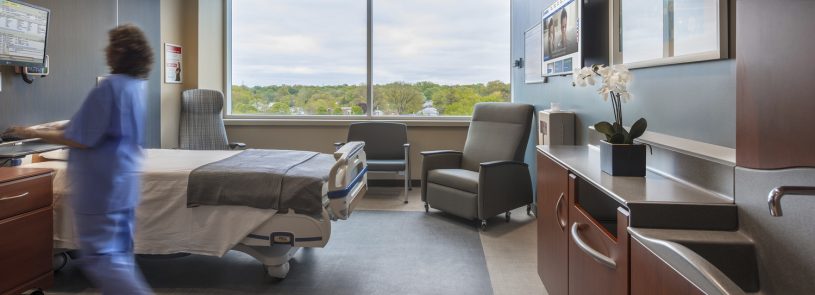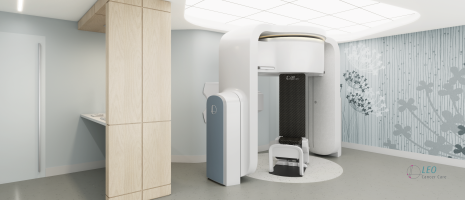From carbon footprints to smart rooms: Six trends to watch in healthcare design

As the healthcare landscape continues to evolve, IMEG’s healthcare leaders from across the country are seeing several emerging trends that are poised to have wide-ranging impacts on facility design and construction. Following are six of the trends and strategies they expect to become more commonplace in 2022 and the years to come.

Focusing on the carbon footprint. With the healthcare sector contributing over 5 percent of the global greenhouse gas emissions and the link between emissions and public health, we are seeing our healthcare clients take a closer look at both their embodied and operational carbon footprint. No longer will carbon reduction simply be a talking point, a “nice to have,” or an item that is later value engineered. Instead, carbon footprint will be the foundation of healthcare design strategies and a mandatory challenge we will address on all healthcare projects. — Mike Zorich, PE, LEED AP, Chief Operations Officer

Leveraging the benefits of post occupancy evaluation. We are having more healthcare clients requesting the design team perform a post occupancy evaluation as part of their contract and we anticipate this being a trend in healthcare going forward. Typically, in the design and construction process, an owner, designer, and contractor may take years working together to define project goals, plan, design, and construct a healthcare facility that meets the needs of their staff and patients. But once the owner occupies the building, the keys are turned over with limited follow-up other than closing out punch list items and a one-year warranty walk-through. The formerly close group of owner, designer, and contractor then move on to their next project without gaining feedback from the occupants or finding out if the building has indeed met the goals of the organization. This is a lost opportunity for the team to gain insight by comparing their planning assumptions with actual building operation. This insight could then be used to fine-tune operations, identify, and solve problems, and gather data that each team member could utilize to justify decisions on future projects. — Carrie Condry, EDAC, NCIDQ, Senior Medical Equipment Planner | Dallas, TX
 Designing for resiliency. Resilient healthcare facilities and infrastructure continue to be a major focus on our healthcare projects. Clients are looking for options for how their facilities can adapt to a multitude of events—man-made, weather-related, or other disaster conditions. Our teams are tasked with finding intentional design solutions that respond to several vulnerabilities in a practical and cost-effective way. It is interesting to see the market continue to evolve on this topic, and we have seen our healthcare clients factor in grid independence or on-site renewables as part of their resiliency planning strategy to best prepare them for future vulnerabilities. — John Costello, PE, LEED AP, Principal/Client Executive | Minneapolis, MN
Designing for resiliency. Resilient healthcare facilities and infrastructure continue to be a major focus on our healthcare projects. Clients are looking for options for how their facilities can adapt to a multitude of events—man-made, weather-related, or other disaster conditions. Our teams are tasked with finding intentional design solutions that respond to several vulnerabilities in a practical and cost-effective way. It is interesting to see the market continue to evolve on this topic, and we have seen our healthcare clients factor in grid independence or on-site renewables as part of their resiliency planning strategy to best prepare them for future vulnerabilities. — John Costello, PE, LEED AP, Principal/Client Executive | Minneapolis, MN
 Assessing hazardous vulnerability: In the wake of the pandemic, wildfires in California, and the cold weather events in Texas in 2021, we have seen a larger focus toward completing a hazardous vulnerability assessment (HVA) integrated within the healthcare design process. These HVAs—a critical component of resiliency and emergency preparedness—have included clinicians’ operations, facilities, and the design team in performing tabletop scenarios, assessing risk, and ultimately finding ways to implement solutions into our designs. Bringing a diverse group of stakeholders into these discussions will always lead to the best outcomes. — Katie Callender, PE, Principal/Client Executive | Reno, NV
Assessing hazardous vulnerability: In the wake of the pandemic, wildfires in California, and the cold weather events in Texas in 2021, we have seen a larger focus toward completing a hazardous vulnerability assessment (HVA) integrated within the healthcare design process. These HVAs—a critical component of resiliency and emergency preparedness—have included clinicians’ operations, facilities, and the design team in performing tabletop scenarios, assessing risk, and ultimately finding ways to implement solutions into our designs. Bringing a diverse group of stakeholders into these discussions will always lead to the best outcomes. — Katie Callender, PE, Principal/Client Executive | Reno, NV
 Adopting Smart Room technology. We expect the continued proliferation of the “smart” patient room/environment of care focused on patient and caregiver experience. Whether it be an inpatient or outpatient setting, patient and even family-controlled devices—phone, tablet, or Alexa—will enable an enriched experience focusing on the patient care journey, health information, and entertainment. This in turn will hopefully impact the cognitive overload of stressed caregivers by providing a “smarter” and digital way to have real-time engagement with patients and their families. — Corey Gaarde, FHIMSS, CHPIMS, Project Executive, Healthcare Information Technology | Naperville, IL
Adopting Smart Room technology. We expect the continued proliferation of the “smart” patient room/environment of care focused on patient and caregiver experience. Whether it be an inpatient or outpatient setting, patient and even family-controlled devices—phone, tablet, or Alexa—will enable an enriched experience focusing on the patient care journey, health information, and entertainment. This in turn will hopefully impact the cognitive overload of stressed caregivers by providing a “smarter” and digital way to have real-time engagement with patients and their families. — Corey Gaarde, FHIMSS, CHPIMS, Project Executive, Healthcare Information Technology | Naperville, IL
 Addressing supply chain challenges. In 2021 the U.S. economy was greatly impacted by issues around the supply chain. The issues affected major equipment, but it also influenced commodity type items such as steel, sheet metal, pipe, conduit, and wire, resulting in large and inconsistent fluctuations in cost and lead times. These issues are expected to continue throughout 2022 and 2023, and we in the AEC industry will need to provide options and solutions to our healthcare clients to address this challenge impacting cost and schedule. We have experienced and anticipate a continued increase in integrated design projects between architects, engineers, and contractors that focus on target value design—partnering with suppliers to design around product availability, pre-purchasing of products, and other collaborative strategies to manage budget and ability to quickly adapt to schedule. — Eric Vandenbroucke, PE, LEED AP, Senior Director of Healthcare
Addressing supply chain challenges. In 2021 the U.S. economy was greatly impacted by issues around the supply chain. The issues affected major equipment, but it also influenced commodity type items such as steel, sheet metal, pipe, conduit, and wire, resulting in large and inconsistent fluctuations in cost and lead times. These issues are expected to continue throughout 2022 and 2023, and we in the AEC industry will need to provide options and solutions to our healthcare clients to address this challenge impacting cost and schedule. We have experienced and anticipate a continued increase in integrated design projects between architects, engineers, and contractors that focus on target value design—partnering with suppliers to design around product availability, pre-purchasing of products, and other collaborative strategies to manage budget and ability to quickly adapt to schedule. — Eric Vandenbroucke, PE, LEED AP, Senior Director of Healthcare











